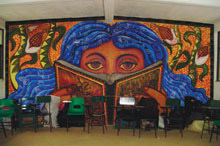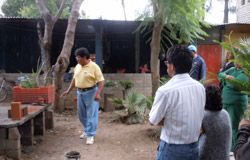In Rural Mexico, Student-Led Education Heals Old Wounds

Residents of San Bartolo Coyotepec contruct an oven with the participation of an Unitierra representative. Photo by Mike Emiliani.
As a university student in the United States, I’ve always thought of “education” and “learning” as synonyms. That’s an assumption that got turned upside down during the five weeks I spent this summer in Oaxaca, Mexico, investigating alternative education methods among indigenous people .
The educators I observed there called what they were doing “participant education.” While each group had a slightly different definition of the concept, certain things stayed consistent everywhere I went.
First, people have a greater control over how they learn and what they learn compared to the formal model of classroom education.
Learning should center on meaningful dialogue between people to question the existing world.
Second, instruction was decentralized. The philosopher Ivan Illich, who was an avid promoter of redefining what education and learning can mean, called this kind of decentralization the “opportunity web.” The four-part web stresses dialogue and skill-sharing between people of different classes, backgrounds, and cultures, and people finding other people with like interests or useful knowledge to help facilitate their learning.
Third, it is transformative. To Paulo Freire, another prominent education theorist, learning should center on meaningful dialogue between people to question the existing world in order to reinvent meaning and purpose.
In order to help you envision this process, I am going to describe an example in which participant educators facilitated the building of a clay oven in a village outside Oaxaca. But before I do that, I’d like to put these projects in context by talking about what education has been expected to do In Mexican history.
A history of distrust
Modern education in Mexico begins with the Liberal Party’s victory over the Conservatives in the 1861 Reform War. Liberals elected Benito Juarez, a native Zapotec from the Sierra of Oaxaca, as the first freely elected president of Mexico. At the time, Mexico consisted of countless groups that spoke different languages, respected different forms of authority, and had different goals about the future of the nation.
The Juarez administration sought to design an education system that would unify these groups and teach them basic skills. Up until this time, education in Mexico was dismal in terms of quality and results, especially among poor and indigenous groups. Illiteracy was rampant.

Freedom to Learn
Unitierra founder Gustavo Esteva tells the story of how this educational network came to be.
Juarez built more schools and overhauled existing curriculums, which up until that point had been created almost exclusively by the Catholic Church. The Juarez plan taught math, science, law, medicine, theater, music, and a myriad of other fields with the goal of creating a more enlightened citizen of Mexico.
A secondary effect of this plan was to decrease the power and influence of the Catholic Church. Before Juarez took office, the church had been the largest untaxed landowner and the largest creator of schools, in which it propagated Catholic teachings and the fear of God. The Juarez administration attacked that power through legislation such as the Ley Lerdo, which forced the church to sell off its land holdings.
However, the indigenous groups Juarez wanted to educate quickly became his greatest problem. Indigenous groups wanted to retain their ways of life, languages, and cultures, while the federal government wanted to replace these with a singular Mexican culture. To the federal government, multiple cultures and languages hindered efforts to establish a singular national identity. Ultimately, the indigenous communities resisted the coercive forces of the Juarez administration in trying to implant reforms onto their communities.
Schools and teachers were forcibly pushed into communities, which were often expected to pay for construction of the school and the salaries of the teachers. The 1844 legislation passed by the Juarez administration required that towns disclose their community budgets and finances to the federal government, for the purpose of finding out how much money they had to erect state schools.
This back and forth continued through several more administrations and has been a major factor pitting the federal government against the indigenous populations of Mexico. The tensions between educational models are only one of the reasons why many of the indigenous groups of Mexico harbor skepticism toward the federal government.
Taking education into their own hands
One of the products of that skepticism has been a movement to build schools that are a better match with indigenous values and lifeways. One of these schools is the Universidad de la Tierra, or Unitierra, an alternative university stationed in the heart in Oaxaca City. The school, founded and led by Gustavo Esteva, has become a model in alternative education. The school emphasizes informal education and the apprenticeship method instead of the “traditional” model of the teacher-student relationship.
While the Unitierra offices can act as a learning commons for students working on apprenticeships through Unitierra, the school is also active in promoting a learning-by-doing approach to education at the request of the communities.

In most cases, classes at Unitierra have no fixed location of education, such as a classroom. Though there is one main building in Oaxaca City where forums within the community are held and students can come to learn, Unitierra also can provide a learning experience to students where they live and work by coming to them
According to Unitierra, participants have complete control over what and how they decide to learn. Esteva believes that this method facilitates a more organic learning pattern and results in better and more detailed retention of information, which can then be readily passed on to another curious student. According to Mr. Esteva, you need someone to educate you, but you can learn by yourself.
Esteva, a former advisor to the Zapatista Army for National Liberation (EZLN), has been a tremendous force for alternative education and the promotion of intercultural dialogue. Born in Mexico City, the young Esteva began working at IBM at the age of 15 as a result of a series of educational programs made possible by the recent implementation of President Harry Truman’s Point Four program. At 22, Esteva left IBM and the private sector after seeing the kind of damage that the major corporations were doing to Mexico and its people.
By 1970, Esteva had been appointed to a position as minister in the cabinet of President Luis Echeverría, a member of the Institutional Revolutionary Party (PRI) who had run on a populist platform. Unsettled by the reality of being placed in a legislative position that disconnected him from the people he was helping to govern, Esteva stepped down from his position.
Esteva’s interests began to move towards the grassroots efforts and organization. As a result of an invitation to a seminar in 1983 in Mexico City, Esteva met the philosopher and educational theorist, Ivan Illich. “His ideas, his words, his writings, were a brilliant intellectual presentation of ordinary people’s common discourse,” Esteva recalls. The two began collaborating in the years to come.
The conception of Unitierra came as a result of concluding that no matter how much curriculums were modified or how creative the teachers were, the school as an institution created many of the problems in education. Preapproved course material that did not have much application in the real world was among the greatest issues, combined with the need for a degree in order to be considered certified to complete a task.
Unitierra in action
One Monday, I shadowed a Unitierra worker named Alberto to an education site (I have changed his name to protect his privacy). A community in San Bartolo Coyotepec, a village just outside the city, had requested the services of Unitierra for an oven-building project. Unitierra works with communities in and around Oaxaca to promote environmentally friendly works and community building exercises. In doing so, volunteerism is the driving philosophy; no one is forced to attend these workshops, but the hope is that their service will act as a learning experience for the participants and an opportunity to learn and share a new skill.
The women also discussed the aesthetic and artistic design of the stove and provided suggestions to the wife based on what they thought would look good.
The project was construction of an energy-efficient adobe stove designed to reach and maintain optimal cooking heat levels while burning less wood. Alberto was the designated “expert” (another worker’s word—not mine) on this particular stove and was going to this community to help show the family and members of the community how to build one.
We arrived at the village and made our greetings, as the 19 participants trickled onto the worksite. All the people were immediate family and members of the health committee, one of the many community-run organizations within the San Bartolo group, in the community, most aged 25 and up. After a few more introductions to the group, the work began.
The women began discussing the different ways in which the stove could be organized. Other housewives shared how their own stoves were set up and arranged for optimal cooking, food preparation, and use of pots and cookware. The women also discussed the aesthetic and artistic design of the stove and provided suggestions to the wife based on what they thought would look good.
Meanwhile, the men conversed casually with one another as they began moving dirt and adobe bricks to the site. Pretty soon, both groups were talking and busily laying out bricks and mud, adjusting, readjusting, and moving parts around until an agreement was made on what should go where.
Four hours had passed and the yard was full of conversation and deliberation, while busy hands put mud and brick into place. At the end of the day, they had completed the stove, with little to no intervention from the Unitierra workers, except in answering questions. Everyone who’d chipped in stood tall on the lawn of this family. Looking at all the dirtied faces, the people’s pride and happiness with what they had accomplished couldn’t have been clearer to me.
This was just one example of participant education that I observed in my time in Oaxaca. Education and learning have become synonymous to many of us, but in this instance, the two words have vastly separate meanings.
The limitations of this model exist only at the limits of an individual’s own curiosities.
To the indigenous communities and groups that cannot afford formal education in Mexico or have rejected the state’s program, this model provides an opportunity to gain a new skill or a new perspective and an understanding of how to use it in a real situation rather than a hypothetical one. This kind of education stresses the learning process and the acquisition of practical skilss over the degree itself. The learning process and skills gained is the ends, not just a means to a degree or certification.
Anyone can take part in his or her own informal education. The limitations of this model exist only at the limits of an individual’s own curiosities. Any person can learn a new skill by themselves, or someone can help facilitate this process, but it is the process and the practical outcome that make this approach so starkly different than the formal model of education.
It is daunting to imagine what results might would come if this method of education was as widely promoted as widespread as the formal one and what would come from a world that taught itself and shared ideas openly.
Interested?
- A California proposal would offset the state’s climate-altering emissions by paying for forest conservation in Chiapas. Could there be unintended consequences in a region with a history of human rights abuse and land grabs?
- Radical homemaker Shannon Hayes: When standardized curricula fall short, food can teach the values I want my kids to learn.
- What really educated people know, by John Taylor Gatto.





